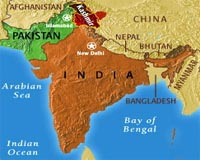| . |  |
. |
Moscow (AFP) Jan 14, 2010 The United States and Russia are "on the verge" of a new nuclear disarmament treaty after months of talks, US Under Secretary of State William Burns said in comments released on Thursday. "We're on the verge of completing the agreement and ... I'm optimistic that we'll complete it soon," Burns said, according to the transcript of an interview released by the US Embassy in Moscow as he was visiting Russia. Washington and Moscow have been seeking to agree the terms of a new pact to replace the 1991 Strategic Arms Reduction Treaty (START), which expired on December 5. US President Barack Obama and his Russian counterpart Dmitry Medvedev had originally sought to have a new treaty by December 5, but talks have gotten bogged down in recent months amid disagreements over various issues. Many of the disagreements have centred on monitoring measures, such as US inspections of Russian missile facilities, which Moscow does not want to be included in the new treaty. "There do remain a few issues, related mainly to verification, that have to be sorted through. But I believe they will be sorted through in the coming weeks," Burns said. Burns added that a new US-Russian treaty would be "a very important signal to the rest of the world," especially ahead of a May review conference on the Nuclear Non-Proliferation Treaty. Burns, who gave the interview to the Russian news website Gazeta.ru, did not elaborate on the results of his two-day visit to Moscow. The Obama administration has made efforts to replace START a key element of its initiative to "reset" US-Russian relations that were badly strained during the previous administration of George W. Bush. START, seen as a cornerstone of Cold War-era strategic arms control, imposed strict limits on the US and Russian nuclear arsenals and set up a system of mutual inspections and data exhcanges to ensure compliance. The broad outlines of the new treaty have been clear since a summit in July, when Obama and Medvedev agreed that the replacement treaty should slash the number of warheads on either side to between 1,500 and 1,675. The two presidents also agreed that the number of "carriers" capable of delivering the warheads should be limited to between 500 and 1,100. The United States has said it currently has some 2,200 nuclear warheads, while Russia is believed to have about 3,000.
Share This Article With Planet Earth
Related Links Learn about nuclear weapons doctrine and defense at SpaceWar.com Learn about missile defense at SpaceWar.com All about missiles at SpaceWar.com Learn about the Superpowers of the 21st Century at SpaceWar.com
 Pakistan warns against 'massive' Indian arms build-up
Pakistan warns against 'massive' Indian arms build-upIslamabad (AFP) Jan 13, 2010 Pakistan voiced concern Wednesday over a "massive" arms build-up by rival India, warning that it could destabilise the regional balance. The National Command Authority (NCA), which oversees the country's nuclear assets, at a meeting took note of developments "detrimental" to the objectives of strategic stability in the region, an official statement said. "India continues to pursue an am ... read more |
|
| The content herein, unless otherwise known to be public domain, are Copyright 1995-2009 - SpaceDaily. AFP and UPI Wire Stories are copyright Agence France-Presse and United Press International. ESA Portal Reports are copyright European Space Agency. All NASA sourced material is public domain. Additional copyrights may apply in whole or part to other bona fide parties. Advertising does not imply endorsement,agreement or approval of any opinions, statements or information provided by SpaceDaily on any Web page published or hosted by SpaceDaily. Privacy Statement |